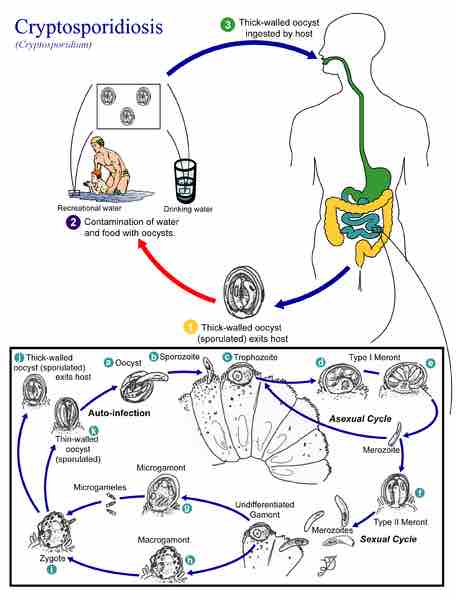Cryptosporidiosis is a type of parasitic disease caused by the parasite Cryptosporidium. Cryptosporidiosis is typically spread through the fecal-oral route and can be spread through contaminated water as well. Cryptosporiodiosis is one of most common waterborne diseases identified worldwide. The transmission of Cryptosporidium is based on successful ingestion of oocysts which are able to implant and infect the epithelial tissue of the intestine, hence, the gastrointestinal symptoms associated with cryptosporidiosis.
Cryptosporidium is classified as a protozoan within the Phylum Apicomplexa. Other pathogens classified in this phylum include the malaria parasite and the parasite that causes toxoplasmosis. The life cycle of Cryptosporidium allows for growth in a single host. The spore phase of the life cycle, also referred to as the oocyst stage, is the stage that allows survival of the pathogen in numerous harsh environments. The oocyst allows for survival against harsh chemicals including harsh disinfectants such as chlorine. The life cycle is characterized by the presence of both an asexual and sexual stage. The oocysts, once ingested, excyst within the small intestine and release sporozoites which attach to the microvilli. The sporozoites then develop into trophozoites and undergo asexual reproduction via schizogony. The trophozoites then develop into Type 1 and Type 2 merozoites which can either cause auto infection (Type 1) or undergo releasal and attach the epithelial cells (Type 2). Once released and attached, they will either develop in macrogamonts or microgamonts which correlate with male and female forms. Sexual reproduction occurs than zyogotes are developed. The zygote further develops into the oocyst which can either reinfect the host by rupturing and releasing sporozoites or be excreted into the environment .

Life cycle of Cryptosporidium
An overview of the life cycle of Cryptosporidium.
The major symptom associated with individuals infected with Cryptosporidium is diarrhea. However, cryptosporidiosis is prevalent in immunocompromised individuals, such as those infected with the HIV virus. The symptoms of cryptosporidiosis in these cases are much more severe and can be fatal. The oocysts can initiate infections by attaching to the brush border of the small intestine and attacking the epithelial cells. Additional symptoms associated with cryptosporidiosis include abdominal cramping, malnutrition, weight loss, and nausea.